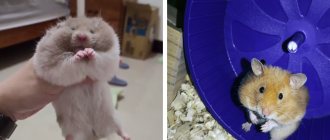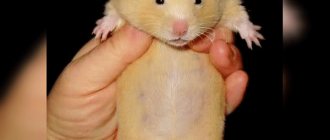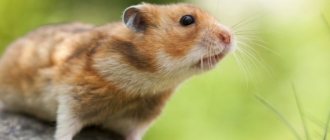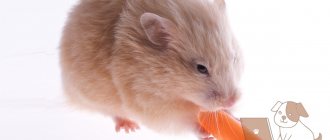Pet information
Let's start with some interesting facts about pet hamsters, whose cages are often installed in houses and apartments around the world:
- There are two versions of the origin of the animal's name. The first claims that our ancestors borrowed it from the ancient Iranian language, it was used in the meaning of “an enemy who throws to the ground.” The second is that it is derived from a combination of Old Church Slavonic and Lithuanian words.
- Often, breeders place pets in pairs to make it more fun for them. This is a serious mistake. Same-sex individuals will regularly fight for possession of the entire territory of the cell; opposite sexes - they will try to isolate themselves from each other as much as possible; when crossing, fights may also arise in order to expand the area of their influence.
- Interestingly, the Vietnamese authorities prohibit keeping hamsters at home under penalty of a hefty fine. They are believed to spread various diseases like rats.
- Almost all Syrian, golden-colored animals are descendants of one female, which 87 years ago gave birth to a litter of 12 individuals.
- Despite the established image of a sleepy, slightly clueless hulk, the animal is quite smart, capable of learning its nickname and responding to it, and also able to entertain its owner with some interesting tricks.
- An interesting feature of hamsters that have been kept in the same cage for some time is the ability to remember and, in the event of a subsequent meeting, recognize their “neighbors.”
- Accelerated metabolism, compared to humans, is the main reason for short life expectancy, and on average the animal leaves its owner after 3-4 years, and only Djungarian hamsters are long-livers of the furry tribe. With proper care, they live up to 5-6 years. A short life by human standards, in the “hamster measurement system” is equivalent to our 75-100 years.
- The pharmaceutical industry uses ovarian cells from female Chinese breeds. From them a substance is extracted, on the basis of which medicines for cancer and multiple sclerosis are made.
- The rodent is one of the three cleanest animals. The presence of an unpleasant odor in the cage is a consequence of the laziness of the owner, and not the dirt bred by the animal.
This is where the interesting or unusual information about domestic hamsters ends.
Smart
Hamsters are very smart:
- they can be trained to do some tricks;
- respond to your own nickname;
- they remember their relatives and neighbors who lived in the cage.
The best time to learn a name and learn tricks is between 2 weeks and 2.5 months. Hamsters can be taught to stand on their hind legs, climb onto a shoulder and sit there like a parrot, roll over, go through an obstacle course, or lift a fake barbell.
Those who love to jump can easily be taught to jump through a hoop. You can combine learned tricks and create a whole circus performance. You cannot train a pregnant animal during the mating period, shout at it and show aggression during training, demand more than the animal can fulfill. Find out how to train your hamster to respond to its name.
Types of Syrian hamsters
There are two most common types of Syrian rodents. By and large, they differ only in their long hair, hence their names: short-haired and long-haired. The latter were given the name Angora. Crossing these species is not recommended! It may turn out that the cub will have a medium coat type, which will be unattractive. A long-haired hamster can still be “satin”. This look implies a satiny shine to the coat. Such hamsters are rare and require special care.
According to the type of color they are distinguished:
Agouti-colored hamsters are the most popular for keeping at home. They have uneven coat coloring. Moving from the base to the ends of the hairs, an ombre effect is created. Solid color is available in various shades. They are also characterized by spots on all parts of the body.
№9
They have very poor eyesight. They suffer from myopia and, like many animals, see everything only in black and white. However, poor eyesight was replaced by an excellent sense of smell. Hamsters easily distinguish each other by smell and also easily recognize their owner by smell.
They are also sensitive to sounds. They can hear in the ultrasonic range.
In addition, they have sensory nerves at the ends of their antennae, which help them sense their surroundings and more easily navigate in the dark.
Video: interesting facts about hamsters
Interesting facts about Djungarian and Syrian hamsters
Why does a hamster bite and how to avoid it
Djungarian hamster (lat. Phodopus sungorus)
belongs to the rodent family. Its natural habitat is the South Siberian steppes. In nature, the Djungarian hamster lives in a hole and does not hibernate in winter. In appearance, the animal looks like a large mouse with ears. Its fur is fluffy; in summer it is gray, with a noticeable dark stripe running along the ridge; in winter the rodent becomes lighter and the coat becomes silver-gray. If you look closely at his habits, they are very similar to human ones. In particular, the manner of grasping food - hamsters hold treats with both paws and look very funny. They have impressive cheek pouches into which they store all their supplies.
Such animals grow up to 10 centimeters in length and weigh no more than 50 grams. These are very sociable and cute pets, with black, attentive beady eyes and alert ears. The soles of hamsters' feet are covered with fur.
You need to handle your pets carefully - they are very fragile. Unlike the similar Campbell's hamster, Djungarian hamsters are more peaceful: their counterparts tend to bite or get scared by sharp sounds, while Djungarian hamsters are peaceful and somewhat phlegmatic
photo: Djungarian hamster weighs no more than 50 grams
Djungarian hamsters are very clean and emit virtually no odor, so they make wonderful pets. They are suitable even for families with small children - they can sleep in their arms for a long time and love to be petted. Hamsters give birth to 2-3 litters per year, each of which contains 3-9 babies. At the age of one month they reach sexual maturity, so they will need to be placed in a separate cage. The pregnancy of a female hamster lasts 16-18 days.
photo: Djungarian hamster lives about 2 years
As for the choice of housing for a hamster, it can be a cage with small cross bars or a glass aquarium. Here you can place a house, a feeder, a drinking bowl, and a wheel for entertainment. If you wish, you can create several tunnels using tubes and hoses - animals love to climb through them. Letting them run around the room, where they can easily get lost, is quite risky; it is better to choose a larger cage.
photo: Djungarian hamster is a nocturnal animal
- In captivity, the Djungarian hamster can live 2-3 years;
- Djungarians are nocturnal creatures, their peak activity occurs in the evening and at night, but during the day they sleep;
- Hamsters are very active creatures; they run long distances per day;
- You will be able to make friends with your pet - at first he will hide in the far corners of the cage, but over time he will respond to your voice, take food from your hands and even doze peacefully on your lap.
If you are interested in buying a Djungarian hamster, then you can see and get to know them live at the Moscow petting zoo "UtiPuti", located near the Molodezhnaya metro station. Zoo staff will be happy to answer all your questions and give the necessary recommendations on keeping and caring for hamsters. Zoo website -
The most interesting facts about hamsters will reveal to you many secrets about them. When nature created these fluffy and charming animals, it did not skimp on imagination.
The word "hamster" means "earth-destroying enemy." Most likely, this means that the animal bends the stems of various cereals to taste the seeds.
From the article you will learn interesting facts about hamsters.
Interesting fact: I didn’t invite you, come on
Syrian hamsters do not like company. Being loners in life, they will constantly fight if kept together, so it is better to keep each one in a separate cage.
Did I invite you to visit? No! So get out of here!
Their territorial nature begins to emerge between 6 and 10 weeks of age, so separate them at this stage.
Prices for Syrian hamsters
The cost of Syrian hamsters varies from place to place. Depends on color, gender or greed of the seller (if you buy at the market). Basically, these animals cost up to 500 rubles. Registered nurseries sell them at a higher price. This is not greed, this is normal, because along with the hamster you are given documents and advice on care and maintenance + perhaps the club itself has certain bonuses that are included in the price, for example a good discount on food or veterinary services). Therefore, from official breeders the price can be more than 1000 and reach 2000 rubles for one hamster.
It is better not to take a Syrian from private hands or on the market. A hamster purchased from a registered nursery is healthier and will live longer.
Photos of Syrian hamsters of different colors (pictures are clickable):
WHITE HAMSTERS
Among all the hamsters, the Djungarian is the only one that changes color from gray to white in the winter. They shed gradually, turning completely white only in January, and a new molt begins in February. Local residents call them “white mice”: the animals often run through the snow, collecting seeds that fall off dry grasses. True, not all animals change into winter coats and not always. It depends on the air temperature and the length of the day. Nevertheless, the winter fur of all hamsters becomes longer and thicker, and the paws and tail of all hairy-footed hamsters are already pubescent.
Djungarian hamsters do not hibernate in winter. In autumn, their body weight even decreases compared to summer (in animals sleeping in winter, on the contrary, it greatly increases due to fat reserves).
Read also: Determining ECU markings by VIN
Diseases and their prevention
Unfortunately, any type of hamster is extremely vulnerable to many colds and infectious diseases. Some of these diseases extremely weaken the animal's body, which can ultimately lead to its death. Including a certain part of the diseases will be caused by improper conditions of detention, and not by the breed characteristics of the species.
We list the most common ailments of hamsters.
Obesity. A common disease among all pets. The reasons are irregular and plentiful feeding together with a sedentary lifestyle. That is why keeping hamsters requires a lot of free space for games and entertainment. In their natural habitat, these animals spend about 90% of their active life in constant motion. Obesity can become a breeding ground for the development of many cardiovascular diseases.
European hamsters are endangered
There are 19 species of hamsters, but only one species, the European hamster, is now critically endangered. Once widespread throughout Europe, the black-bellied European (or common) hamster is critically endangered. It is the only representative of the genus Cricetus. Its range and population have declined significantly in Western, Central and Eastern Europe. Changes in agricultural practices, commercial and residential development, pollution and climate change are the biggest threats to these small rodents.
What can you feed hamsters besides dry food?
A mandatory addition to the diet is fresh grass and greens, especially in spring and summer. Useful vegetation:
- fresh dandelion leaves;
- carrot and beet tops;
- lettuce and celery;
- alfalfa and plantain;
- garden rose petals.
To feed your hamster greens at home, you need to be sure that they are completely safe. It’s better to grow this healthy supplement yourself: in your summer cottage or on a windowsill. Animals love fragrant parsley very much, but it should be given in small portions, since excess will have a laxative effect on the hamster’s stool. By analogy, exclude parsley from the diet of a pregnant or lactating female.
When feeding your pet celery, monitor the animal’s reactions, since the concentration of harmful substances in this plant may well be too high for a small organism. Park areas away from busy city roads are suitable for collecting fresh weed. The best option is grass collected outside the city, away from dusty highways. If it is not possible to collect fresh grass, you can germinate wheat or oats at home. Choose the juiciest greens for your pet, be sure to wash and lightly dry before feeding.
Place young shoots of fruit or berry crops in the cage so that the rodent has the opportunity to grind down its teeth. Twigs of apple and pear trees, raspberries, currants and rose hips, linden and acacia work well. First, you need to rinse it well under running water, pour boiling water over it and let it cool, after which you can safely offer it to the animal.
In winter, provide your hamster with plenty of hay with the addition of wheat ears. It is not forbidden to pour grain feed directly into the litter, as some breeders do. The rodent will be interested in obtaining grains, choosing the most delicious ones for itself. Sometimes you can treat your hamster to homemade popcorn, excluding additives in the form of sugar, salt and flavor enhancers.
If dry food contains a meager amount of vegetables and fruits, feed your pet with the following crops:
- pumpkin and zucchini;
- sour varieties of apples;
- sweet peppers and radishes;
- strawberries and wild strawberries;
- cherries and currants;
- cucumbers and tomatoes;
- bananas in any form.
It is better to give vegetables without peeling and in small portions. Do not feed hamsters dried fruits, especially those with excess sugar. As an exception, you can treat your pet to raisins or a dried apple slice.
Once or twice a week, rodents can be fed cottage cheese, boiled eggs, chicken breast, lean beef and rabbit meat, and boiled boneless fish. Eating animal products will not harm the rodent, since its wild counterparts can eat about 60% of such food. Twice a week you can give your pet grasshoppers or worms from a pet store, remembering to monitor portions in moderation.
Fun Fact #5 – Close the Door!
They love to sleep in enclosed spaces. To do this, you can place items such as paper towel rolls and small flowerpots in the cage.
Yes, one-room apartment. But it's yours. All. And you’ll have to pay your mortgage in a week!
For bedding, use a clean, dust-free, absorbent material such as shredded paper or hay. Avoid using pine and cedar shavings; their fumes can cause breathing problems!
As a general rule, shavings, corn cobs, and walnut shells should not be used as bedding because they are dusty and indigestible when eaten.
Hamsters also love to dig, so provide them with plenty of nesting material (such as white paper towels or shredded paper).
Interesting facts about golden hamsters
Animals of this breed living in captivity are very friendly and not at all aggressive. This is what distinguishes them from their wild counterparts. But at the same time, they skillfully guard their territory and will not allow strangers to be on it. For them there is no concept of family ties.
These animals prefer to live alone and are capable of killing a weaker hamster. Therefore, owners should keep them alone.
Scientists have proven that Syrian hamsters can eat almost anything. Therefore, in addition to seeds and grains or fruits, they also need to eat animal protein. In the wild, they can eat insects, carrion, or even hunt other small animals. In addition, sometimes females can destroy their offspring, which their owners try to prevent in captivity.
At home, these animals should be given lean and thoroughly cooked poultry or fish. Otherwise, these small and usually calm animals become quite aggressive and can bite.
Djungarian hamsters
The Djungarian hamster is another famous domestic representative of the hamster family. It is characterized by a height of up to 10 centimeters and a weight of 35–65 grams. They are characterized by fur-covered feet, as well as a recognizable dark (usually gray) stripe on the back. These animals have almost no tail.
Their fur is very beautiful due to the presence of white hairs. Despite the fact that now small animals of this species are considered to be domestic, they can sometimes be found in the wild in semi-deserts or dry steppes, for example, in Khakassia, in the south of Western Siberia and in the Dzungarian Alatau. Hamsters usually live 2-3 years, but can sometimes live up to four years.
Mankind first learned about the Djungarian hamster in 1773, thanks to an entertaining and fairly reliable description of the famous traveler and scientist Peter Simon Pallas. He saw this animal during his trip through the territories of what is now Kazakhstan. Even at that time it had an almost modern appearance. And the hamster’s habits have hardly undergone any changes since that time.
In winter, hamsters of this species do not sleep. They can actively move even in the snow and search for food in it.
During shedding, animals' fur may change color. This usually occurs at temperatures below sixteen degrees Celsius for a long time.
They have fluffy gray fur with a recognizable gray stripe. At the same time, in winter it noticeably brightens, becoming silver.
In the Altai Territory you can often find these small furry animals even at an altitude of up to 3000 above sea level.
Djungarian hamsters live in slightly branching burrows. Their homes have a number of holes and chambers.
They prefer to be extremely active at night and in the evening. At the same time, rodents sleep during the day.
In severe frosts, as well as when there is a lack of oxygen or stress, these animals can fall into a peculiar state of torpor, which scientists call torpor. At the same time, their body temperature can drop by as much as 20 degrees. This phenomenon was first described in laboratory conditions, but it also occurs in the wild.
Hamsters of this breed live for approximately 2.5 years, but in good conditions they can live longer.
Rodents of this species are popular among many pet lovers from all over the world. Therefore, you can find them almost everywhere. Such animals do not require special knowledge or serious care from their owners. Their content is simple and cheap.
Food, cages and toys for hamsters are inexpensive and always available at any pet store. At the same time, you can easily do a lot of things to maintain them with your own hands.
Djungarian hamsters, like most representatives of other breeds of hamsters, are cheerful and inquisitive. And even a small child can handle their contents. If desired, such animals can be trained and taught simple tricks. They are believed to lift a person's mood and relieve stress. But at the same time, parents who want to get a hamster for their child should remember that the life of such an animal is short-lived. Therefore, his death can become a real tragedy for a child or a very impressionable person.
Make large reserves of food
Domestic hamsters, even if they get enough food, tend to stock up. They hide part of the food in their cheek pouches and carry it to a storage area. When his supplies are removed during cage cleaning, he becomes stressed.
In the wild, hamsters are rodents that, in the course of their life activity, cause enormous damage to agriculture by storing grain for the winter. Farmers sometimes go to great lengths to get rid of these pests. However, this wild rodent is fearless and cunning. Rapid reproduction, high vitality and unpretentiousness, the ability to quickly build burrows and underground passages to them make it very difficult to combat such pests. These underground burrows can store quite extensive supplies of hamsters from local agricultural fields.
Did you know? The dug burrows can reach 1.5 m in depth and 8 m in width. Hamsters are quite capable of storing up to 90 kg of reserves in their underground storage facilities, and this is not the limit.
HOUSEHOLD HOSTS
The burrow of the Djungarian hamster is not simple: several entrances lead vertically to a depth of 20 to 50 cm, where they are united by a common corridor that goes even deeper, sometimes with turns. The nesting chamber can be located at a meter depth! The animals spend most of the day in burrows, appearing on the surface for only two to three hours at night. Djungarian hamsters go out to feed already in complete darkness, but can linger after dawn. They feed on seeds, greens and insects, and the proportion of animal food can be very large. Having filled its cheek pouches with seeds, the hamster either takes the prey to the hole, or, if the shelter is far away, sets up temporary “storerooms”, sprinkling heaps of seeds with sand and leaving scent marks. Hamsters are nearsighted, so smells are of great importance to them, and they leave a lot of marks with urine, feces and even just bathing in sand.
Interesting fact #1 - they were recently discovered!
It turns out that they were discovered not so long ago. Hamsters were first found in the Syrian desert less than 100 years ago. The most popular type (among small pets) is the Syrian.
Oh, come on!? We've lived there longer than you. It is still unknown who discovered whom first.
These fluffies, also called golden (golden) hamsters or teddy bears, grow up to 12-15 cm in length and live for two to three years.
How to determine the sex of a hamster?
This information may be important if you keep several animals at once and do not plan to reproduce them. Finding out what gender an animal is is not very difficult. To do this, you need to examine him, but this should not be done abruptly so that he does not get stressed. Calm the animal down and treat it to something tasty. Gently take the animal in your arms and hold it on the fold of skin between the shoulder blades, but do not pull.
Inspect the back. Males have pronounced sexual characteristics, but females do not. You can presumably determine the sex simply by the size of the animal - males are usually much larger than females. The latter also have prominent nipples in the abdominal area. Determining the gender of a newborn animal is somewhat more difficult. This can be done along the gap between the anus and urinary opening. For girls this distance is usually less than for boys.
Fun Fact #2 - Sleeping at night? Nope...))
They are nocturnal creatures. Homa usually sleeps all day and can be very noisy at night. You have to put your energy somewhere.
Sport - is life! Well, what are you looking at? I'd rather go for a run!
It's best to keep them out of your bedroom if you don't want them to disturb your sleep. They can run on a wheel in a cage all night long. It is better to keep your hamster at home in a quiet, calm place, not in the bright sun, so that he can burrow and sleep in his nest.
Interesting things about babies
Let's look at some interesting information about these cute pets:
These rodents got their name from the Avestan language. Translated, it sounds like this: “the enemy who throws you to the ground.” This translation is justified by the fact that in order to collect seeds from the stems, the baby bends them down. This is the interesting origin of the familiar name. These rodents come in a variety of colors and sizes. For example, the body length of different individuals can vary from 5 to 34 cm. But it is easy to recognize a hamster, regardless of the species. They have well developed cheek pouches.
These rodents can live in the mountains at an altitude of up to 3.5 km; we are talking about individual species. Parents can eat their cubs, so the male is often separated from the offspring, and the female must be monitored. These rodents are nocturnal, so if you are not ready to fall asleep to the noise of an active animal running around in a cage, you should refuse to purchase such a funny and active pet. They are good swimmers; in order to float on the water like a float, they take air into their cheek pouches. They have no fear of heights, so unattended pets can fall from a height and get injured
Be vigilant and do not leave children unattended; carelessness can lead to the death of the child. They prefer to live alone. In the hole of this rodent there are many passages and passages in which they navigate. The most ordinary hamster can stock up on food weighing up to 90 kg. They store even more than they can eat during the winter. Cells extracted from Chinese hamster ovaries are used to produce medicines for a number of serious diseases. Some breeds of dwarf hamsters have the ability to delay the birth of new offspring if they have not yet finished feeding previously born offspring.
This is how nature took care of them. They do not have the ability to clearly see what is happening around them; they cannot distinguish colors. Despite poor eyesight, these animals have excellent hearing and sense of smell. The animals record their path with the help of odorous glands that are present in their bodies.
If we compare the age of a person with the age of this rodent, it would be about one year in the life of a hamster and twenty-five years in the life of a human. It is worth noting that these are very funny and smart pets. They can remember their name if the owner is patient. They can also be trained to carry out certain commands. In one night of hunting, this little one can run up to ten kilometers, just as domestic animals run a lot in a wheel. Babies are already born with teeth. Their teeth grow throughout their lives, so they need to be ground down on hard surfaces, this can be a special pebble or twigs. The weight of grains that they can carry in their cheek pouches can be 20% greater than the weight of their body. Just imagine how strong and resilient they are. The diet may contain not only grains and berries, but also small insects. Life expectancy ranges from two to three years, but this is not the limit; there are cases with long-lived pets.
Before you decide to have such an interesting and cute pet in your home, you need to familiarize yourself with its features so that you don’t regret your choice in the future. Despite the fact that this rodent is very small, being its owner is a big responsibility, do not forget this.
They swim well
Hamsters can swim by taking air into their cheek pouches. They usually undertake such a feat if necessary. Wild hamsters are more courageous and resilient, but for domestic sissies, swimming can be stressful.
However, among the dzungarians there are sometimes individuals who do not mind wallowing in the water.
Important! For the most part, hamsters are inhabitants of steppes and deserts. Do not force your pets to swim when bathing. For these rodents, such swimming is not always enjoyable; moreover, the animal may choke or water may get into the ears.
Interesting facts about hamsters
Hamsters are wonderful pets. These are playful, active, cute rodents who enjoy care, affection, and games with their owner. About 25 breeds of animals have been bred in the world, differing in size and appearance. Many amazing and unexpected stories can be told about large European, tiny dwarf, wild American, and popular Djungarian hamsters. Below are the most amusing and interesting facts about these wonderful and cute pets.
- The largest breed is the European hamster. The length of its body reaches 30 centimeters. And the smallest rodent is the dwarf hamster. It rarely grows more than 10 centimeters. But they live much longer than other breeds: up to four years!
- The animals have a unique ability: they can store uneaten or found food behind their cheeks for quite a long time in special bags in order to eat it later. Animals can easily hold food in their mouths, the weight of which reaches 20% of their body weight!
- The most popular and widely bred breed is the Syrian hamster, which is brown in color with a golden tint.
- Some breeders call male rodents hogs, and females sows. Although their pets have nothing to do with pigs.
- Hamsters have been known for a long time. This biological species was first discovered in the semi-deserts of Syria. But the animals got their name from the German word “hamstern”, which means “to accumulate, store up”.
- Hamsters' vision is poor and colorless. Therefore, in studying the world around them, they rely more on a keen sense of smell and excellent hearing.
- Rodents have special glands on their bodies that secrete an odorous secretion. Animals use this liquid to mark the road.
- Hamsters' incisors, like those of all other rodents, grow throughout their lives and require grinding down with rough food. And the cubs are already born with teeth.
- Animals can climb mountains to a height of up to four kilometers. They are also excellent swimmers, drawing in air with their cheek pouches and using them as air mattresses.
- The owner must build a running wheel in the pet’s cage. The hamster is so nimble and agile that it can cover a distance of 10 kilometers in a wheel overnight!
- Almost all Syrian hamsters existing today are descendants of a single female. In 1930, she gave birth to 12 cubs, giving birth to the breed.
- The habitat of wild rodents is rapidly declining, so many populations are on the verge of extinction. The Syrian hamster and its close relative, Newton's hamster, are already listed in the Red Book as an endangered species.
- Sex cells from males of the Chinese breed are used in pharmaceuticals to produce drugs against serious diseases, including oncology.
- In Vietnam, it is legally prohibited to breed and keep hamsters as pets. They are believed to carry many dangerous infections. Disobedience to the law results in heavy fines.
- Representatives of the forest North American species love to store shiny objects they find in their burrows: buttons, brooches, beads, coins. When they take a thing, they usually put a pebble or a stick in its place, as if exchanging.
- Hamsters just look stupid and awkward. In fact, they are smart, agile and quick-witted creatures. Pets respond to a nickname, remember their cage neighbors and relatives, and can easily learn several tricks.
- One year of a hamster's life is equal to almost 25 human years. It's a pity that furry pets live so short.
- Pregnant females of some dwarf breeds have the ability to delay childbirth if they have not yet nursed cubs from a previous litter.
- The assumption that hamsters are social animals is incorrect. In fact, they prefer to live alone and do not tolerate other individuals nearby. If you place several males in one cage, a fight with a bloody and even fatal outcome is inevitable.
- It is also incorrect to believe that hamsters eat only plant foods. In their natural habitat, animals often feast on insects, and at home they can be given boiled chicken or lean fish.
Interesting fact No. 6 - oh, teeth, my teeth...
Hamsters' teeth grow constantly. Therefore, you need to give them something to chew to keep their teeth healthy.
Like people, we wake up every morning and go brush our teeth (just kidding)
Wooden blocks and toys made from hay are good for this purpose, but avoid cedar, pine, and soft plastic items because they can be harmful if ingested.
How do they understand the world around them?
As we have already seen, hamsters do not have the best vision, so they cannot rely on it alone. This led to the development of other senses that allowed him to complement what he saw.
The hamster’s cage is full of various objects: a feeder, a drinking bowl, a wheel, a sleeping place and some others that the owners could provide for him to live comfortably. The animal effortlessly finds what it needs at any time of the day, and since it is not always possible to rely on vision, it resorts to the help of smell, hearing and touch, which are much better developed in hamsters than in humans.
In addition to the basic methods of touch, hamsters can use special organelles - vibrissae. This is what zoologists call the thick whiskers of rodents located not far from the nose. They grow from a special hair bag that has many nerve endings, so hamsters immediately react to objects touching their whiskers. This helps them explore the surrounding space and communicate with the owner (the animal will feel the one who is in constant contact with it).
Hamster cheek pouches
This feature distinguishes hamsters from other rodents. The animal uses its cheeks to hide food and other things that interest it. The cheeks are a kind of bag for the rodent, with the help of which it carries things to its home. Greedy animals can even put a heavy nut on their cheek. The hamster will not spit out a shiny find, even if it finds something tasty.
A hamster can put a load in its cheeks, which will amount to a fifth of the weight of the rodent itself.
Cheek pouches are not only a reliable pocket for food, but also excellent airbags while swimming. Hamsters, taking air into their cheeks, float perfectly on the surface of the water.
Records: the fattest hamster in the world, the largest and the smallest
About 19 breeds of rodents with cheek pouches are known. Among them there are tiny dwarfs - PeeWee from Great Britain, which is only 2.5 cm long including its tail. But this is not a natural phenomenon, but a physical deviation, due to which the animal stopped growing in childhood.
Hamster - dwarf PeeWee
Among Radde's wild hamsters, a male is registered, 35 centimeters long and weighing just over a kilogram. This fattest hamster has prepared supplies for winter not only in the pantry, but also accumulated on his sides.
Although the average Radde hamster stands out among its relatives: its weight ranges from 500 to 700 g. People call it nothing more than a “dog”.
Hamsters eat their babies.
Animal cannibalism has been the subject of numerous scientific studies, and even today it is impossible to say with complete certainty what the exact reasons for such behavior are. In hamsters this phenomenon is of particular curiosity and concern, but in general we can confirm that this is because the mother of the hamster considers her children to be weak or unable to survive...
However, there are other possible reasons that confirm why your hamster is killing its babies as well;
- The stress of feeding and raising very large litters.
- Nutrient deficiencies in baby hamsters.
- The presence of male hamsters in the cage.
- Lack of space in the hamster cage.
- The breed is too far from the hamster's nest.
If you want to make sure that all of your hamsters' offspring survive, we recommend that you read our article on how; prevent your hamster from eating his offspring.
Hamster teeth don't stop growing
Hamster teeth, as well as other rodent teeth, never stop growing . Therefore, the hamster needs to constantly wear its teeth to maintain an optimal and symmetrical tooth length. In the wild, hamsters seek out small pieces of broken tree trunks or branches, which they chew to maintain proper dentition. However, in the case of pet hamsters, it is their guardians who should be responsible for offering these items to their pets.
In general, we recommend offering organic fruit branches to your hamster. Ideally, you should consult with your veterinarian on how to properly deliver your hamster with proper dental care . It is also very important to make sure that the branches or pieces of wood offered to your hamster are organic. The reason for this is that some of the wood may be coated with pesticides, which are poisonous to hamsters. For more information, check out our article: Caring for Hamster Teeth.
Hamsters are susceptible to stress.
In nature, hamsters are easy prey for many predators. For this reason, hamsters are constantly vigilant and can quickly react to any danger. Consequently, hamsters are prone to stress and therefore require a very positive environment in order to feel comfortable and safe.
Stress in hamsters includes many possible causes, such as:
- Sedentary lifestyle.
- Poor mental stimulation.
- Lack of hygiene in your environment (cage).
- Nutrient deficiency.
- Pathologies that cause hamsters pain or change their senses.
Therefore, it is very important to be aware of the symptoms of stress in your hamster. If you notice any signs of stress in your pet's hamster, we recommend taking him to the vet to deal with the stress as quickly and properly as possible. For more information, see our article on; symptoms of stress in hamsters.










